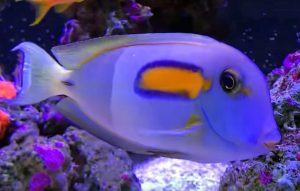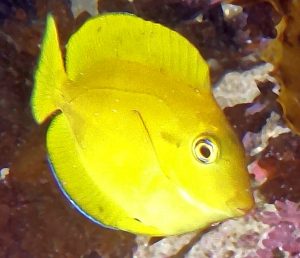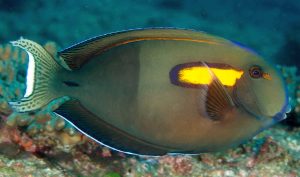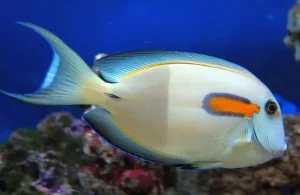The Orangeshoulder Tang (Acanthurus olivaceus) known to tropical fish keeping enthusiasts as Orange Epaulette Surgeonfish, Orangespot Surgeonfish, Orangeband Surgeonfish, Olive Tang, Yellow Orange Tang, and Orangeshoulder Surgeonfish is found throughout tropical Indo-West Pacific waters.
The Orangeshoulder Tang ranges from Christmas Island and the Cocos Keeling Islands to southern Japan; Western, North, and Eastern Australia, Indonesia, Polynesia, the Phillippines, and Hawaii.
Adult Orangeshoulder Tangs are a solitary species that are occasionally seen in small schools along the outer reef slopes at depths from 30 to over 150 feet where they feed on detritus, filamentous algae, and the film of diatoms on the sea bed. Adults frequently form schools in more exposed areas of the outer reef slopes where they can be seen grazing with parrotfish and other species of surgeonfish that have the same dietary needs.
Juvenile Acanthurus olivaceus are normally found in small groups around more sheltered structure in shallower water than adults.
The Orangeshoulder Tang is a deep bodied, laterally compressed oval species that can reach 14 inches in length.
Juvenile Orangeshoulder Tangs have a solid yellow body color with just the slightest hint of blue fringing on the anal and dorsal fins.
Adult Orangeshoulder Tangs have a greyish to olive brown body with a sharp vertical line that separates the paler front half of the fish from the darker hind portion. They have a distinctive orange or red bar surrounded by a purplish black margin immediately behind the top of the gill cover with blue and orange lines at the bases of the fins. The blue highlighted dorsal and anal fins are long, low, and extend almost to the caudal peduncle. The caudal fin is lyre shaped with points that grow longer as the fish mature. Like all surgeonfish, Acanthurus olivaceus posses a pair of scalpel like scales that project upward from the caudal peduncle.
Adult males develop a convex snout that clearly differentiates them from females. Females grow much faster than males and are usually an inch or so larger than males as adults. Males and females can change color from dark to pale almost instantaneously when disturbed.
Orangeshoulder Tangs are best housed in a FOWLR or reef aquarium of at least 180 gallon capacity with a crushed coral or sandy substrate, substantial amounts of mature live rock arranged into caves, crevices, and overhangs for them to hide among, and plenty of free swimming space. They are peaceful fish that are perfect for community tanks but can get aggressive with other surgeonfish of their own genus.
In a FOWLR tank good tankmates include Clownfish, Dwarf angelfish, Dottybacks, Dartfish, Gobies like the Mandarin Goby, Blennies like the Lawnmower Blenny or the Bicolor Blenny, Dartfish, Damselfish, and Anthias.
Although Orangeshoulder Tangs are well suited for large reef systems and will generally ignore invertebrates and corals, a hungry specimen may occasionally nip on LPS corals or the slime that clams produce.
Like all tangs, Orange Epaulette Surgeonfish need a lot of swimming area and water turbulence to thrive, so a strong protein skimmer, good filtration, and regular small water changes are mandatory to prevent illness. In the wild cleaner wrasses (Labroides sp.) remove parasites from their bodies, so adding one or more to the tank should also be considered.
Orangeshoulder Tangs are egg scatterers that have never been bred in an aquarium environment. In the wild, females disperse their eggs into the water column near the surface where the males fertilize them as they drift toward the surface.
The Orangeshoulder Tang is an omnivore that requires plenty of marine algae and dried seaweed to strengthen their immune systems, reduce aggression, and improve their overall health. In their natural habitat they graze on detritus and algae growing on the seabed, as well as the film of diatoms and filamentous algae growing on the sand and on other substrates.
In an aquarium environment they should be offered Spirulina, frozen vegetables, herbivore flake foods, dried marine algae, and occasionally Mysis shrimp for protein. Dried nori tied to a rock or clipped on a veggie clip should also be provided at least 3 times per week.
Sea Veggies, Seaweed Salad, and Ocean Nutrition are all ideal products that are convenient to use.
Because the Orangeshoulder Tang (Acanthurus olivaceus) has not been bred in captivity, all specimens kept by tropical fish keeping enthusiasts are wild caught and are priced accordingly.
They are available from specialty fish shops and online from wholesalers, retailers, and trans shippers at the following approximate purchase sizes: Juvenile Small: 2″ to 3″; Changing: 3″ to 4″; Adult Small: 4″ to 5″; Medium: 5″ to 6 1/2″; Large: 6-1/2″ to 8″; XLarge: 8″ or Larger. Prices can range from $ 25.00 for juveniles to $ 579.00 for adults depending on the area of capture.
Minimum Tank Size: 180 gallons
Aquarium Type: Reef or FOLR
Care Level: Moderate
Temperament: Semi Aggressive
Aquarium Hardiness: Very Hardy
Water Conditions: 72-78° F, dKH 8-12, pH 8.1-8.4, sg 1.020-1.025
Maximum Size: 14″
Color Form: Black, Blue, Yellow
Diet: Herbivore
Compatibility: Reef or FOWLR
Origin: Indo-Pacific, Red Sea, Africa, Hawaii, Australia
Family: Acanthuridae
Lifespan: 10 – 15 years (35 years in the wild)
Aquarist Experience Level: Intermediate





